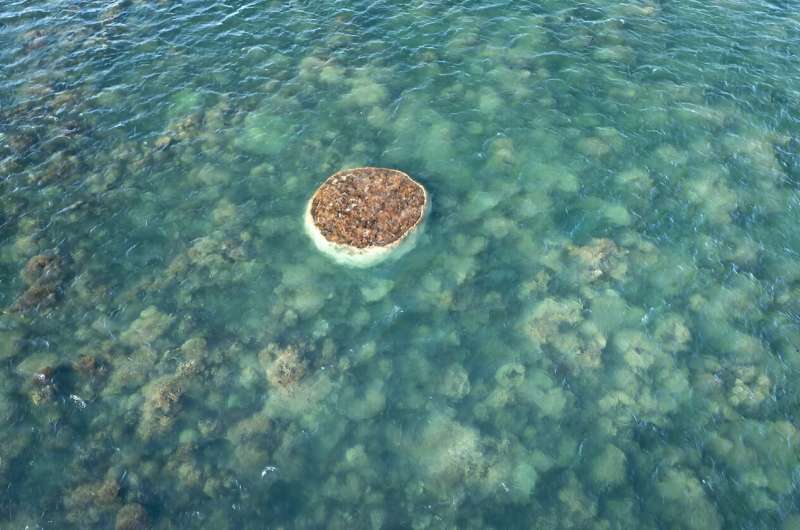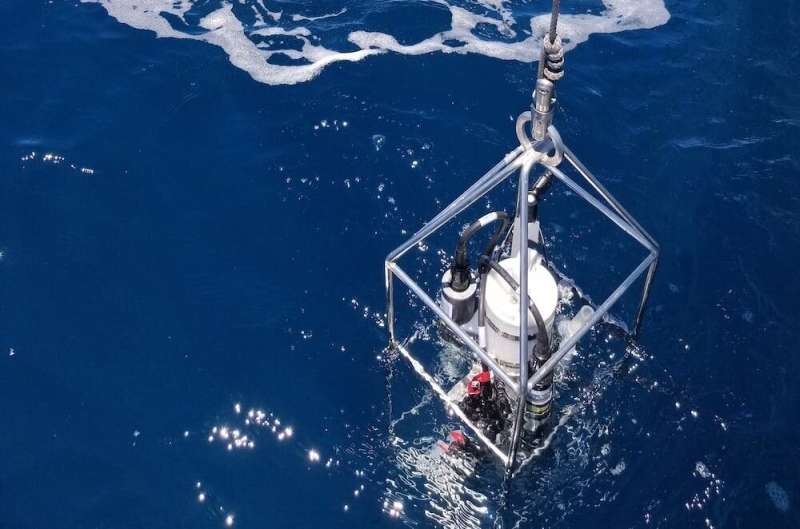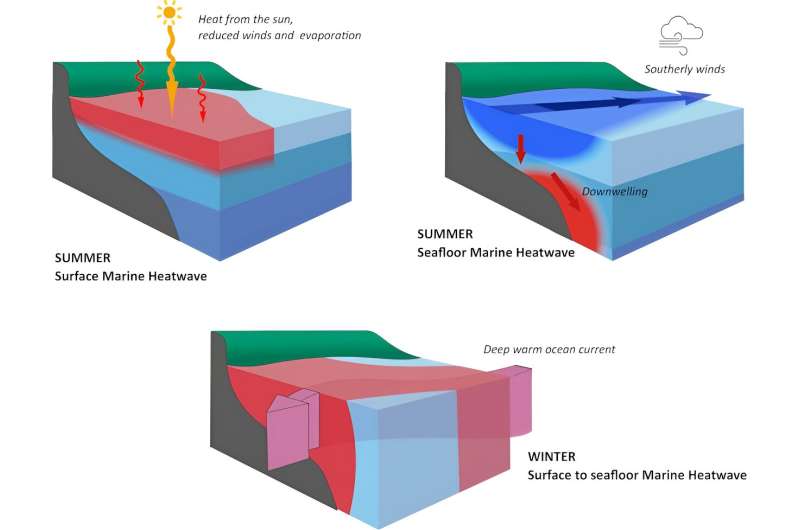This article has been reviewed according to Science X's editorial process and policies. Editors have highlighted the following attributes while ensuring the content's credibility:
fact-checked
peer-reviewed publication
trusted source
written by researcher(s)
proofread
Marine heat waves don't just hit coral reefs. They can cause chaos on the seafloor

Most of us know what a heat wave feels like on land—sweltering heat for days. But oceans get heat waves too. When water temperature goes over a seasonal threshold for five days or more, that's a marine heat wave. They do their worst damage in summer, when the ocean is already at its warmest, but they can occur any time of year.
Over 90% of the heat trapped by greenhouse gases has gone into our oceans. So it's no surprise marine heat waves are getting much more intense and more frequent. This year has been off the charts. From April this year, the world's average ocean temperature has been the highest ever recorded.
Since the 1980s, satellites have revolutionized ocean science by making it possible to take daily measurements of ocean temperatures. But satellites watch from above. They can't see what's happening below the surface.
Our new research published in Communications Earth & Environment explores what's happening in deeper waters. It turns out, marine heat waves aren't just on the surface. In the most devastating marine heat waves, heat can penetrate right down to the sea bed. Remarkably, some heat waves only affect the seafloor.
Why do deep marine heat waves matter?
While we usually only see sea creatures at the surface of the ocean, there's life all the way down. In the shallower seafloors of the continental shelf—the sunken parts of our continents—live fish, kelp beds, sponges, cold water corals, shellfish and crustaceans.
These shallow oceans are, on average, less than 100 meters deep. When the shelf ends, there's usually an abrupt slope into the deep ocean, where there are kilometers of water between surface and seabed.

Marine heat waves are damaging to life in the seas covering the continental shelf. Creatures here are sensitive to extreme temperatures, just like those at the surface. But "extreme" to them is different to what we think of as extreme. If you're used to water at 12℃, a heat wave of 15℃ can be devastating.
When marine heat waves strike, they can kill. More than a billion sea creatures died during a single heat wave off the coast of the western United States and Canada in 2021. This year, extreme heat waves have hit large parts of the oceans during the northern summer.
Fish and other creatures that can move do so, heading towards the poles or down deeper in search of cooler water. Those that can't have to endure it or die. Heat waves can trigger migration. New species arrive, seeking refuge and can alter the ecosystem.
We don't know much about deeper marine heat waves
The seas covering the continental shelf are relatively shallow compared to the kilometers of water in the deep oceans. But even so, it's impossible to see what's going on below using satellites or high-frequency radar.
The sea is a hostile environment. Instruments are subject to high pressure, corrosive salt water and marine organisms like oysters and sponges settling on them. This is one reason why we only have very limited data on long-term trends in temperatures under the surface. But these records are vital to calculate typical temperatures for the time of year and to figure out what constitutes an extreme.
Australia is one of the few places generating this kind of valuable data long-term. Off the coast of the southeast lie many oceanographic moorings—a floating collection of sensors anchored to the bottom. One of these has been measuring daily temperatures from the surface to the seafloor 65 meters down since 1993.

Our earlier research found marine heat waves at depth can actually be more intense and last longer compared to the surface. But why?
In our new research, we looked at the temperature data closely. We found marine heat waves come in a variety of types and have different causes. We also found some types of marine heat wave are more likely during particular seasons.
For instance, winter marine heat waves often run from surface to seafloor. They occur when the powerful, deep and warm East Australian Current snakes westward towards the coast. As the current swings over the continental slope, it drags warm water over the shelf and close to the coast.
In summer, Australia gets two very different types of heat wave in our oceans. The first occur when we get blue-sky weather. With few clouds, more heat from the sun gets into the oceans. They can also occur when there are weaker winds and less ocean cooling from evaporation. These heat waves are confined to the surface and a few meters below.
Then there's the second, a very weird heat wave system that only appears close to the seafloor. These are produced when strong wind creates currents driving warm, shallower water down to the bottom. On the east coast, these currents come from cold winds from the south. So even while you're shivering through cold winds from the Southern Ocean, the ocean seafloor may be sweltering through a heat wave. These may be the most destructive to ecosystems but go all but unnoticed.
Marine heat waves are not created equally
Our research has shown marine heat waves come in different flavors. That matters, because it will allow us to get better at predicting if a heat wave is about to strike our oceans. And it will let us anticipate which parts of the water column are about to be hit, and which ecosystems.
Of course, slowing ocean warming and preventing marine heat waves from damaging ecosystems means slashing carbon emissions. But while we work on that, this knowledge could give us time to find strategies to reduce the undersea death toll—and the damage to tourism and fishing which rely on these ecosystems surviving.
More information: Amandine Schaeffer et al, Seasonal stratification and complex local dynamics control the sub-surface structure of marine heatwaves in Eastern Australian coastal waters, Communications Earth & Environment (2023). DOI: 10.1038/s43247-023-00966-4
Journal information: Communications Earth & Environment
Provided by The Conversation
This article is republished from The Conversation under a Creative Commons license. Read the original article.![]()





















